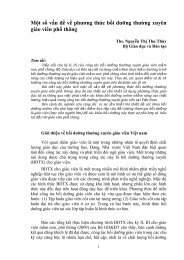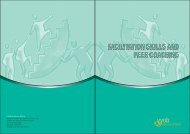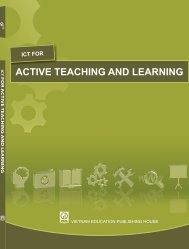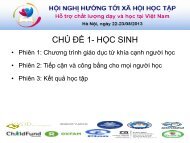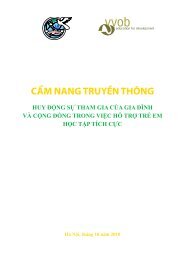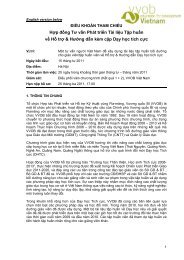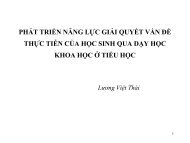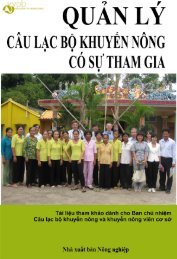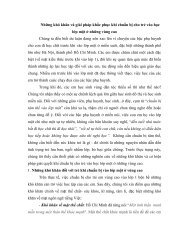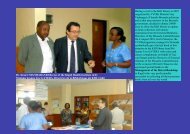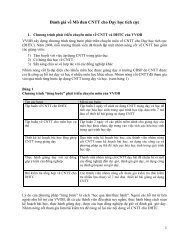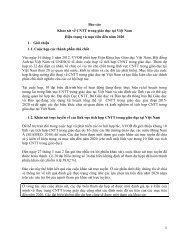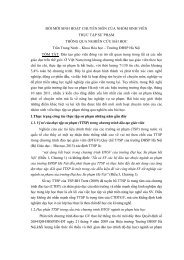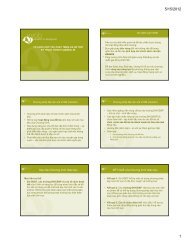Indicator<strong>Year</strong>Military expenditure (7) 281 USD 2005 (est)Literacy rate adult population (+ 15yrs) (3) Literacy (functional) : 61.5% and 2005numeracy (functional): 64.5%Teacher/pupil ratio primary education (5b) 45:1 2009Teacher/pupil ratio secondary education (5b) 36:1 2009Corruption perception index(0=highly corrupt; 10=clean) (6)3.5 2009Sources: (1) UNDP Development Report 2009, (2) Central Bank of <strong>Kenya</strong> (3) <strong>Kenya</strong> Adult Literacy Survey 2006,(4) <strong>Kenya</strong> Bureau of Statistics <strong>Kenya</strong> Demographic and Health Survey June 2010, (5a) MOE Education Facts andFigures 2002-2008, (5b) (AG) PS MOE presentation during budget Joint Budget Meeting March 2010 (6)Transparency International Global Corruption Barometer 2009,(7) www.GlobalSecurity.org, (8) www.IndexMundi.com (9) World Bank Report on <strong>Kenya</strong> 21 March 2010,(10)Ministry of Finance <strong>Kenya</strong> Budget Speech 13 June 20101.2. Recent historyThe current president, Mwai Kibaki, came to power, for a second term, through the controversialelections of December 2007 that resulted in violent clashes which lead to more than 1,300 deaths and300,000 internally displaced people. It required the intervention of the international community (UnitedNations, African Union) to bring the country back from the brink of civil war and to forge a coalitiongovernment with Raila Odinga of the Orange Democratic Movement (ODM) filling a newly createdposition of Prime Minister.The first Kibaki government (2003 – 2007) of the National Rainbow Coalition (NARC) could not deliveron its promises of economic revival and ―zero tolerance towards corruption‖. A new proposedconstitution was rejected by 57% of the voters in a historic referendum, in november 2005. The ―Nocamp‖of the NARC-government went on to form the ODM.Since then, the proposed new constitution has been reviewed afresh, generating heated public andparliamentary debates on issues such as land ownership, abortion, kadhi courts (islamic familycourts). There will be a new referendum on 3 August 2010.1.3. Political context and perspectives1.3.1. Home affairsUp to early 2008, when the post-election violence erupted, <strong>Kenya</strong> had been a beacon of stability in avolatile region. Two years later, the country seems to have recovered from the tribal based politicalantagonism. The International Criminal Court received the ―go-ahead‖ to bring the mastermindsbehind the violence to book, helping the healing process. But there are still undercurrents, that mightsurface again at the next elections, in December 2012?Conflicts such as local battles between ethnic groups for water resources or grasing land are stilloccuring. Occasionally, some clashes erupt at the borders with neighbouring countries such asEthiopia, Sudan, Somalia. Over the years, there has been an increase of small ordonance andweapons, mainly as a result of the the influx of displaced people from neighbouring countries inconflict. <strong>Kenya</strong> was in the 14th position (out of 177) in the Failed States Index 1 2009 of the Fund forPeace (Washington).1 The Failed States Index uses parameters such as demografic pressure, displaced people, unbalanced economic development,poor services, human rights violations... The Fund for Peace‟s mission is ―to prevent war and to reduce causes of war‖.<strong>Kenya</strong> - <strong>Multi</strong>-<strong>Year</strong> <strong>Programme</strong> <strong>2011</strong>-<strong>2013</strong> 10/148
1.3.2. International relations<strong>Kenya</strong> is member of many international organisations: United Nations, ACP (Africa, Carribean &Pacific), AU (African Union), COMESA (Common Market for Eastern and Southern Africa) 2 , WorldTrade Organisation, IGAD (Intergovernmental Authority on Development in East Africa) 3 , NEPAD(New Partnership for African Development)The African seat of the United Nations is in Nairobi. UNEP (United Nations Environment <strong>Programme</strong>)and Habitat (Human Settlements) also have their head office in Nairobi. Over the past three decades,<strong>Kenya</strong> has had an important influence in de peace processes in the Horn of Africa, especially forSudan and Somalia. <strong>Kenya</strong> still hosts tens of thousands of displaced people from these countries,many of them in camps. Internationally, <strong>Kenya</strong> is seen as a ―moderate‖ partner.The United States of America see <strong>Kenya</strong> as an ally in the battle against extreme regimes andterrorism. The country still has special ties with Great Britain and has a good relationship withthe Europian Union (with a very big delegation in Nairobi). The EU is <strong>Kenya</strong>’s largestdevelopment partner contributing € 383 million for the period 2008-<strong>2013</strong> in support of <strong>Kenya</strong>’s“Vision 2030”. As is the case with other African countries, <strong>Kenya</strong> is increasing its links withChina.1.4. Socio-economic context and perspectivesThe Human Development Index of <strong>Kenya</strong> 4, 5 has fluctuated from 0.533 (1990) over 0.491 in 2004 to0.541 in 2009. In the UNDP report of 2009, <strong>Kenya</strong> was occupying the 147 th place out of 182 countriesin the world – (in 2004, it was ranked 152 nd ). Life expectancy stood at 58 in 2007 (of which 48‖ healthyyears‖)The human poverty index of persons living below US$1.25 a day (poverty measure) stood at 19.7% inthe period 2002 – 2007/ Persons living below US$ 2.00 a day stood at 39.9% in the same period.However, <strong>Kenya</strong>‘s economy is recovering steadily from four successive shocks (post election violencefollowed by global financial, fuel and food crises in 2008, and drought in 2009) and is forecast to growat 4.0 percent in 2010, according to a new World Bank report 6 . It even has the potential to improvefurther to 4.9 percent in <strong>2011</strong> if no shocks occur. “After two years of low growth, most <strong>Kenya</strong>ns in 2010will again experience improving living conditions. But <strong>Kenya</strong> could do even better, and benefit fromthe strong growth momentum in the rest of East Africa.”The <strong>Kenya</strong> Economic Update describes the<strong>Kenya</strong>n economy as ―running on one engine‖ since growth is imbalanced, predominantly driven bydomestic consumption fuelled by imports. Exports, it explains, are weak — shrinking from 40 percentof total output in the 1960s to 26 percent in 2009 — due to the underperformance of the agricultureand manufacturing sectors. This import-led growth has also created a large current account deficit.See also table higher (paragraph 1.1.) for other socio-econonomic indicators.1.5. Important transversal themes1.5.1. GenderDe <strong>Kenya</strong> Government recognizes ―Gender‖ as a transversal theme. However, gender inequalityremains a key issue. Women account for only 30 percent of wage employment and 24 percent of civilservice employment, mainly in the lower cadres. There is still under-representation of women indecisionmaking positions (e.g 10% in parliament and 17% as ministers).2 Angola, Burundi, Comoren, D R Congo, Djibouti, Egypt, Eritrea, Ethiopia, <strong>Kenya</strong>, Madagascar, Malawi, Mauritius, Namibia,Rwanda, Seychelles, Sudan, Swaziland, Uganda, Zambia, Zimbabwe.3 Djibouti, Ethiopia, <strong>Kenya</strong>, Somalia, Sudan and Uganda4 Source: UNDP, Human Development Report 2009,5 HDI ( with a value between 0 and 1) is the average of three factors: average life expectancy at birth (benchmark 85yrs),education for all (basic + adults), accepable standard of living (per capita income).6 World Bank, <strong>Kenya</strong> Economic Update June 2010<strong>Kenya</strong> - <strong>Multi</strong>-<strong>Year</strong> <strong>Programme</strong> <strong>2011</strong>-<strong>2013</strong> 11/148



